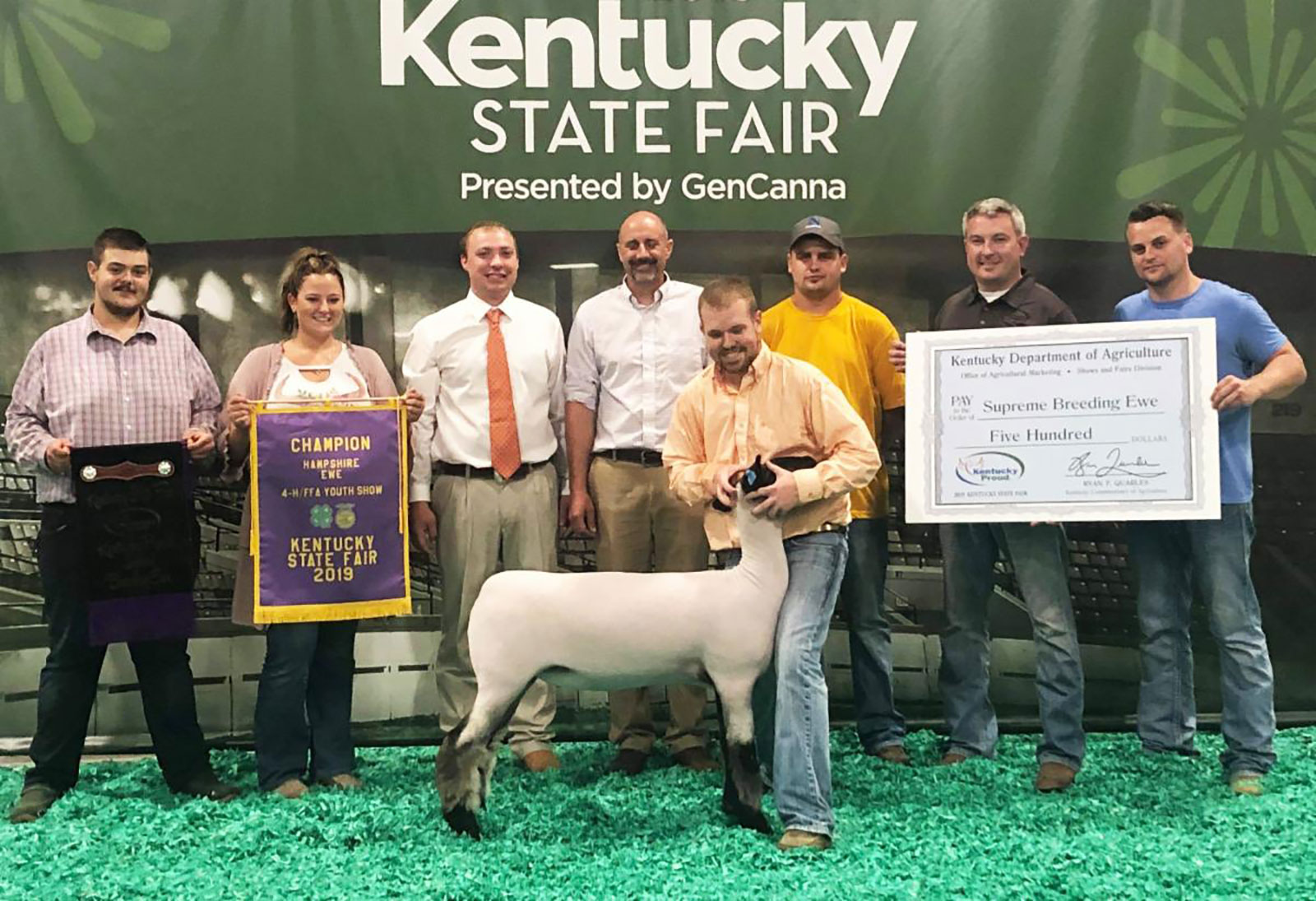
Wrapping up his show career by winning three championships at the 2019 Kentucky State Fair, Chris Hinkle, front, now raises sheep for others to show. Among those honoring him was Kentucky Commissioner of Agriculture Dr. Ryan Quarles, second from right.
FEB
During Lamb Month, one Ky. sheep producer is all show
By Chris Aldridge
Kentucky Ag News
Most Kentucky sheep farmers raise their animals for their meat and wool, but Chris Hinkle raises his for show … literally.
Hinkle is raising this year’s “crop” of 28 lambs at his farm, Hinkle Club Lambs near Harrodsburg. Hinkle does it in his spare time when not working as the Kentucky Department of Agriculture’s Cervid (Deer) Program Coordinator in Frankfort. He is the son of Allen Hinkle, manager of the KDA’s Amusement Ride Safety Branch.
“It’s my hobby,” Chris said. “You’ve gotta have a mad love for it.”
Chris, 23, has been raising lambs for 18 years, ever since he started showing them at age 5. Now he breeds his 26 mature sheep and sells their offspring to be prepared and shown for 4-H and FFA projects.
“All my sheep are raised as show animals, just like I raised and showed my own show animals,” he said.
Chris uses artificial insemination to impregnate his ewes. The procedure costs $250 to $300 per ewe.
“We’ve been blessed that our conception rate is 75 to 80 percent,” he said, noting the remaining 20 to 25 percent of his ewes that don’t get pregnant are mated with a resident ram.
“Our high rate is due to the management of our ewes,” he added. “The biggest challenges in Kentucky are parasites and keeping their feet clean and trimmed. If one has sore feet or is limping, we don’t breed her because her body won’t take the extra stress.”
After breeding in late July or early August, Chris keeps his pregnant ewes comfortable by keeping them as cool as possible under continuously-running fans in the barn.
If all goes well, after a 147-day gestation, the baby lambs are born in late December.
“Normally, Christmas is not spent too far from the barn,” he said.
After being weaned from their mothers at two months old, most of the lambs normally sell for around $500 each through photos on Hinkle Club Lambs’ Facebook page. The 4-H and FFA “projects” are picked up in mid to late March to be shown throughout the summer at KDA district shows, county fairs, and possibly the State Fair, at national shows like North American International Livestock Exposition, and at out-of-state “jackpot” shows.
Chris wrapped up his show career at the pre-pandemic 2019 Kentucky State Fair by winning three championships. He won the open and junior breeding shows for Hampshire ewes, as well as the Kentucky Proud Ewe Junior Breeding Show. He also won commissioner’s showmanship awards in 2016 and 2017.
“Preparing sheep for showing is a full-time job,” Chris said. “I’d get to the barn at 6 o’clock (in the morning), I’d work 8 to 5 (p.m.), then I’d be back in barn until 10 at night.”
Now, that he and his wife are expecting their first child, Chris is content to provide the animals for others to show.
“I’ve sold sheep to Pennsylvania, Illinois, West Virginia, and Kentucky, of course,” he said. “When you’re selling show lambs, genetics and backdrop pictures of (past) winners really entice buyers. The more winners, the more interest you have.”
Chris held back a few of his best lambs to sell through an online auction site. Six lots brought an average of $717.
“Show animals is a highly competitive industry,” he said. “Online sales allow people across the country to view your animals and creates a fairer market for you and the buyer. We’ve done online sales for two years, and we’ll continue to do that.”
The sheep that don’t sell for show are sold for meat. Chris said the market price for lamb is about $3.50 per pound, compared to around $2 for beef.
“It’s such a smaller animal, so you don’t get the big chunk check like you do with cattle,” he added. “But sheep take a lot less input, so their price per unit compares pretty well.”

